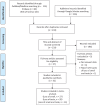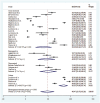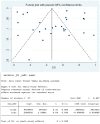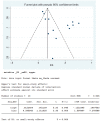Systematic Review and Meta-analysis of Smell and Taste Disorders in COVID-19 - PubMed (original) (raw)
Review
. 2020 Sep 11;4(3):2473974X20957975.
doi: 10.1177/2473974X20957975. eCollection 2020 Jul-Sep.
Affiliations
- PMID: 32964177
- PMCID: PMC7488903
- DOI: 10.1177/2473974X20957975
Review
Systematic Review and Meta-analysis of Smell and Taste Disorders in COVID-19
Titus Sunday Ibekwe et al. OTO Open. 2020.
Abstract
Objective: Loss of smell and taste are considered potential discriminatory symptoms indicating triaging for coronavirus disease 2019 (COVID-19) and early case identification. However, the estimated prevalence essential to guide public health policy varies in published literature. This meta-analysis aimed to estimate prevalence of smell and taste loss among COVID-19 patients.
Data sources: We conducted systematic searches of PubMed, Embase, Web of Science, and Google Scholar databases for studies published on the prevalence of smell and taste loss in COVID-19 patients.
Review methods: Two authors extracted data on study characteristics and the prevalence of smell and taste loss. Random-effects modeling was used to estimate pooled prevalence. Subgroup analysis and meta-regression were conducted to explore potential heterogeneity sources. This study used PRISMA and MOOSE guidelines.
Results: Twenty-seven of 32 studies reported a prevalence of loss of smell, taste, or both from a combined sample of 20,451 COVID-19 patients. The estimated global pooled prevalence of loss of smell among 19,424 COVID-19 patients from 27 studies was 48.47% (95% CI, 33.78%-63.29%). Loss of taste was reported in 20 studies and 8001 patients with an estimated pooled prevalence of 41.47% (95% CI, 3.13%-31.03%), while 13 studies that reported combined loss of smell and taste in 5977 COVID-19 patients indicated a pooled prevalence of 35.04% (95% CI, 22.03%-49.26%).
Conclusions: The prevalence of smell and taste loss among COVID-19 patients was high globally, and regional differences supported the relevance of these symptoms as important markers. Health workers must consider them as suspicion indices for empirical diagnosis of severe acute respiratory syndrome coronavirus 2 infection.
Keywords: COVID-19; SARS-CoV-2; anosmia; coronavirus infection; gustatory loss; olfactory loss; severe acute respiratory syndrome.
© The Authors 2020.
Figures
Figure 1.
Preferred Reporting Items for Systematic Reviews and Meta-Analyses (PRISMA) flow diagram for study selection and exclusion.
Figure 2.
Forest plot for loss of smell in COVID-19 patients.
Figure 3.
Forest plot for loss of taste in COVID-19 patients.
Figure 4.
Forest plot for loss of smell and taste in COVID-19 patients.
Figure 5.
Forest plot of loss of smell by types of study design.
Figure 6.
Forest plot of loss of taste by types of study design.
Figure 7.
Forest plot of loss of smell and taste by types of study design.
Figure 8.
Funnel plots for loss of smell.
Figure 9.
Funnel plots for loss of taste.
Figure 10.
Funnel plots for loss of smell and taste.
Similar articles
- The Prevalence of Olfactory and Gustatory Dysfunction in COVID-19 Patients: A Systematic Review and Meta-analysis.
Tong JY, Wong A, Zhu D, Fastenberg JH, Tham T. Tong JY, et al. Otolaryngol Head Neck Surg. 2020 Jul;163(1):3-11. doi: 10.1177/0194599820926473. Epub 2020 May 5. Otolaryngol Head Neck Surg. 2020. PMID: 32369429 - Olfactory and Gustatory Dysfunction in 2019 Novel Coronavirus: An Updated Systematic Review and Meta-analysis.
Esmaeili M, Abdi F, Shafiee G, Asayesh H, Abdar ZE, Baygi F, Qorbani M. Esmaeili M, et al. Int J Prev Med. 2021 Dec 14;12:170. doi: 10.4103/ijpvm.IJPVM_484_20. eCollection 2021. Int J Prev Med. 2021. PMID: 35070203 Free PMC article. Review. - Objective Sensory Testing Methods Reveal a Higher Prevalence of Olfactory Loss in COVID-19-Positive Patients Compared to Subjective Methods: A Systematic Review and Meta-Analysis.
Hannum ME, Ramirez VA, Lipson SJ, Herriman RD, Toskala AK, Lin C, Joseph PV, Reed DR. Hannum ME, et al. Chem Senses. 2020 Dec 5;45(9):865-874. doi: 10.1093/chemse/bjaa064. Chem Senses. 2020. PMID: 33245136 Free PMC article. - Prevalence of Smell or Taste Dysfunction Among Children With COVID-19 Infection: A Systematic Review and Meta-Analysis.
Yan Q, Qiu D, Liu X, Guo X, Hu Y. Yan Q, et al. Front Pediatr. 2021 Aug 3;9:686600. doi: 10.3389/fped.2021.686600. eCollection 2021. Front Pediatr. 2021. PMID: 34414141 Free PMC article. - How common are taste and smell abnormalities in COVID-19? A systematic review and meta-analysis.
Ahmad S, Sohail A, Shahid Chishti MA, Aemaz Ur Rehman M, Farooq H. Ahmad S, et al. J Taibah Univ Med Sci. 2022 Apr;17(2):174-185. doi: 10.1016/j.jtumed.2021.10.009. Epub 2021 Nov 15. J Taibah Univ Med Sci. 2022. PMID: 34803567 Free PMC article. Review.
Cited by
- Factors associated with loss and recovery of smell and taste after COVID-19 infection.
Razura DE, Badash I, Wrobel B, Hur K. Razura DE, et al. Laryngoscope Investig Otolaryngol. 2024 Sep 23;9(5):e70014. doi: 10.1002/lio2.70014. eCollection 2024 Oct. Laryngoscope Investig Otolaryngol. 2024. PMID: 39314517 Free PMC article. - Living and Coping with Olfactory and Taste Disorders: A Qualitative Study of People with Long-COVID-19.
Moro-López-Menchero P, Martín-Sanz MB, Fernandez-de-Las-Peñas C, Gómez-Sanchez SM, Gil-Crujera A, Ceballos-García L, Escribano-Mediavilla NI, Fuentes-Fuentes MV, Palacios-Ceña D. Moro-López-Menchero P, et al. Healthcare (Basel). 2024 Mar 30;12(7):754. doi: 10.3390/healthcare12070754. Healthcare (Basel). 2024. PMID: 38610176 Free PMC article. - Predictors of anti-SARS-CoV-2 seropositivity: An Egyptian population-based study.
El-Ghitany EM, Ashour A, Farghaly AG, Hashish MH, Omran EA. El-Ghitany EM, et al. Infect Med (Beijing). 2022 Jun;1(2):113-123. doi: 10.1016/j.imj.2022.06.003. Epub 2022 Jun 17. Infect Med (Beijing). 2022. PMID: 38013717 Free PMC article. - Recovery Patterns of COVID-19 Related Smell Disorders: An Analysis of the Available Evidence.
Orji FT, Akpeh JO, Okolugbo NE. Orji FT, et al. Indian J Otolaryngol Head Neck Surg. 2023 Dec;75(4):4179-4189. doi: 10.1007/s12070-023-04005-8. Epub 2023 Jul 3. Indian J Otolaryngol Head Neck Surg. 2023. PMID: 37974870 - Olfactory dysfunction among patients with COVID-19.
Alkholaiwi FM, Altamimi AF, Almalki HH, Almughaiseeb FA, Alsubaie SS, Alsayahi HS, Alhijli FW, Alobaishi RS, Agrawal A, Alqahtani ZA, Alotaibi FZ. Alkholaiwi FM, et al. Saudi Med J. 2023 Nov;44(11):1085-1103. doi: 10.15537/smj.2023.44.11.20230264. Saudi Med J. 2023. PMID: 37926445 Free PMC article.
References
- European Centre for Disease Prevention and Control (ECDC). COVID-19 situation update worldwide, as of 27 May 2020. Accessed May 28, 2020 https://www.ecdc.europa.eu/en/geographical-distribution-2019-ncov-cases
- Iacobucci G. Sixty seconds on . . . anosmia. BMJ. 2020;368:m1202. - PubMed
- Abalo-Lojo JM, Pouso-Diz JM, Gonzalez F. Taste and smell dysfunction in COVID-19 patients [published online May 29, 2020]. Ann Otol Rhinol Laryngol. - PubMed
Publication types
LinkOut - more resources
Full Text Sources
Miscellaneous









